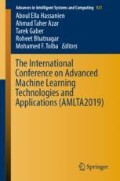Abstract
Nowadays cancer is considered one of the most killing diseases. Traditional cancer therapy leads to dangerous side effects on healthy tissues. A recent direction has been proposed to overcome these side effects. This direction is to use Nano-robots to deliver drugs directly to tumor cells without harming healthy ones. In this paper, we propose a new Nano-robots control strategy that uses Directed Particle Swarm Optimization (DPSO) algorithm for delivering Nano-robots to the cancer area. A Quorum Sensing (QS) algorithm is also used in this strategy to control drug concentration in the cancer area. The results show that using the proposed control strategy increases the rate of killing cancer cells efficiently. This study also proposes to use a certain number of Nano-robots for destroying 100 cancer cells.
Access this chapter
Tax calculation will be finalised at checkout
Purchases are for personal use only
References
Devasena Umai, R., Brindha Devi, P., Thiruchelvi, R.: A review on DNA nanobots - a new technique for cancer treatment. Asian J. Pharm. Clin. Res. 11(6), 61–64 (2018)
Zhao, Q., Li, M., Luo, J.: Relationship among reaction rate, release rate and efficiency of nanomachine-based targeted drug delivery. Technol. Health Care 25, 1119–1130 (2017)
Eberhart, R., Kennedy, J.: A new optimizer using particle swarm theory. In: Proceedings of the Sixth International Symposium on Micro Machine and Human Science, pp. 39–43 (1995)
Ahmed, S.: Nano-Robotics Control for Biomedical Applications (Unpublished Doctoral Dissertation). Ain Shams University, Cairo, Egypt (2014)
Cao, J., Li, M., Wang, H., Huang, L., Zhao, Y.: An improved bacterial foraging algorithm with cooperative learning for eradicating cancer cells using nanorobots. In: Proceedings of the IEEE International Conference on Robotics and Biomimetics, Qingdao, China, pp. 1141–1146, 3–7 December 2016
Chen, Y., Shi, S., Yao, X., Nakano, T.: Touchable computing: computing-inspired bio-detection. IEEE Trans. Nanobiosci. 16(8), 810–821 (2017)
Ezzat, D., Amin, S., Shedeed, H.A., Tolba, M.F.: Directed particle swarm optimization technique for delivering nano-robots to cancer cells. Accepted in the 13th IEEE International Conference on Computer Engineering and Systems (ICCES 2018) (2018)
Zhao, Q.Y., Li, M., Luo, J., Li, Y., Dou, L.H.: A quorum sensing algorithm to control nanorobot population and drug concentration in cancer area. In: IEEE International Conference on Robotics and Biomimetics, ZhuHai, China, pp. 42–47 (2015)
Ummat, A., Sharma, G., Mavroidis, C., Dubey, A.: Bio-nanorobotics: state of the art and future challenges. In: Biomedical Engineering Handbook. CRC Press, London (2005)
Cavalcanti, A., Shirinzadeh, B., Fukuda, T., Ikeda, S.: Nanorobot for brain aneurysm. Int. J. Robot. Res. 28(4), 558–570 (2009)
Cavalcanti, A., Shirinzadeh, B., Kretly, L.: Medical nanorobotics for diabetes control. Nanomedicine 4, 127–138 (2008)
Cavalcanti, A., Shirinzadeh, B., Freitas, R., Hogg, T.: Nanorobot architecture for medical target identification. Nanotechnology 19, 1–15 (2008)
Cavalcanti, A., Freitas, R.: Nanorobotics control design: a collective behavior approach for medicine. IEEE Trans. Nanobiosci. 4, 133–140 (2005)
Cavalcanti, A.: Assembly automation with evolutionary nanorobots and sensor-based control applied to nanomedicine. IEEE Trans. Nanotechnol. 2, 82–87 (2003)
Cavalcanti, A., Freitas, R.: Autonomous multi-robot sensor-based cooperation for nanomedicine. Int. J. Nonlinear. Sci. Numer. Simul. 3, 743–746 (2002)
Lewis, M., Bekey, G.: The behavioral self-organization of nanorobots using local rules. In: Proceedings of IEEE International Conference on Intelligent Robots and Systems, pp. 1333–1338 (1992)
Chandrasekaran, S., Hougen, D.: Swarm intelligence for cooperation of bio-nano robots using quorum sensing. In: Bio Micro and Nanosystems Conference, San Francisco, p. 104 (2006)
Zhang, S., Li, S., Guo, Y.: Cooperative control design for nano-robots in drug delivery. In: Guo, Y. (ed.) Selected Topics in Micro/Nano-Robotics for Biomedical Applications, pp. 101–123. Springer, New York (2013)
Ahmed, S. Amin, S.E., Alarif, T.: Simulation for the motion of nanorobots in human blood stream environment. In: Proceedings of Scientific Cooperation International Workshops on Electrical and Computer Engineering Subfields, pp. 70–75. Koc University, Istanbul/Turkey (2014)
Ahmed, S., Amin, S.E., Alarif, T.: Efficient cooperative control system for pH sensitive nanorobots in drug delivery. Int. J. Comput. Appl. 103(1), 39–43 (2014)
Ahmed, S., Amin, S.E., Alarif, T.: Assessment of applying path planning technique to nanorobots in a human blood environment. In: Proceedings of the UKSim-AMSS 8th European Modeling Symposium on Mathematical Modeling and Computer Simulation, Pisa, Italy, pp. 45–51, 21–23 October 2014
Hassanien, A.E., Alamry, E.: Swarm Intelligence: Principles, Advances, and Applications. CRC – Taylor & Francis Group (2015). ISBN 9781498741064 - CAT# K26721
Lambe, A.: Reinforcement learning for optimal path length of nanobots using dynamic programming. In: Proceedings of IEEE International Conference on Industrial and Information Systems, Peradeniya, Sri Lanka (2017)
Author information
Authors and Affiliations
Corresponding authors
Editor information
Editors and Affiliations
Rights and permissions
Copyright information
© 2020 Springer Nature Switzerland AG
About this paper
Cite this paper
Ezzat, D., Amin, S., Shedeed, H.A., Tolba, M.F. (2020). A New Nano-robots Control Strategy for Killing Cancer Cells Using Quorum Sensing Technique and Directed Particle Swarm Optimization Algorithm. In: Hassanien, A., Azar, A., Gaber, T., Bhatnagar, R., F. Tolba, M. (eds) The International Conference on Advanced Machine Learning Technologies and Applications (AMLTA2019). AMLTA 2019. Advances in Intelligent Systems and Computing, vol 921. Springer, Cham. https://doi.org/10.1007/978-3-030-14118-9_22
Download citation
DOI: https://doi.org/10.1007/978-3-030-14118-9_22
Published:
Publisher Name: Springer, Cham
Print ISBN: 978-3-030-14117-2
Online ISBN: 978-3-030-14118-9
eBook Packages: Intelligent Technologies and RoboticsIntelligent Technologies and Robotics (R0)

